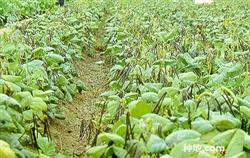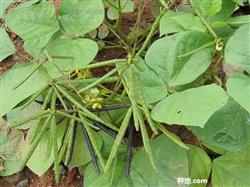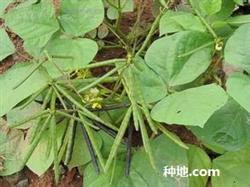How to grow mung beans with high yield?

How to grow mung beans with high yield? Please guide that the price of mung bean is relatively stable in recent years, coupled with lax soil requirements, simple planting, and the area is expanding year by year, which has become a good project for farmers to grow rich. The developed countries do not attach importance to the production of miscellaneous grains and beans. After China's entry into WTO, the export volume of mung beans has increased, and the price has risen steadily, which has become the most competitive industry in the international market. At present, due to the aging of mung bean varieties and backward cultivation techniques, the yield of mung bean is low, which affects the benefit of mung bean. Therefore, the selection of new varieties and new cultivation techniques are the guarantee of high yield and high efficiency of mung bean. First, the selection of new varieties 1, green pearl long pods, large-grain, high-quality, high-yield mung bean varieties, because its leaves are like watermelon leaves, so farmers call watermelon mung beans. There are six outstanding characteristics: ① growth potential: plant height 50-55 cm, branches 3-5, stout stems, lodging resistance. ② leaf shape is peculiar: the leaf edge is deeply engraved, three-lobed leaves, very similar to watermelon leaves, good ventilation and light transmission, high pod setting rate, suitable for close planting, overcoming the shortcomings of poor ventilation and falling flowers and pods in common mung bean leaves. ③ has many pods: 40-50 pods per plant, up to 100 at most. Pods 11-14 cm long, 12-15 pods per pod, not fried pods, can be harvested at one time. ④ grain large quality: beans cylindrical, large and uniform, bright green, glossy, white navel, 1000-grain weight of more than 80g, green weight of 15-20g than big pigeon, good commercial, best-selling market. ⑤ has strong stress resistance: drought resistance, heat resistance, disease resistance, barren resistance, dry and thin land, hilly land can be planted. The growth period is 85 (90 days) and sowing in summer is about 70 days, which is suitable for planting in most parts of the country. High and stable yield of ⑤: generally, the yield is about 2500 kg per hectare, which is more than 30% higher than that of the green series of large parrots. 2. A new super high-yield mung bean variety with green harvest and dense pod type. The growth potential is strong, the plant height is 50-60 cm, the stem is stout, has 4-6 branches, resistant to lodging. The leaves are oval and the leaves are thick. There are dense pods, many long pods, 13-15 cm long pods, 5-7 pods per cluster, a maximum of 11, and abundant top pods. There are 50-70 pods per plant, with a maximum of 128. 12-15 grains per pod, large and uniform, bright green, good glossiness, about 70 grams per thousand seeds, in line with the export standard. The root system of mung bean is twice as much as that of other mung beans, and it has strong drought resistance, disease resistance, heat resistance, wind resistance, barren resistance, dry thin land and sloping land. The growth period is about 85-90 days, and the summer sowing is 65-70 days. All the areas where mung beans can be planted can be planted. You can grow two crops a year in the south. It has high and stable yield and great potential to increase production. The general yield per hectare is 2500 (about 3000 kg), which is 30% more than that of the large parrot green series. 2. New cultivation techniques. 1. Mung bean is resistant to drought and barren, and its requirements for soil are not strict. It can be planted in early and thin land and sloping land. It is better to choose land with medium fertility and should not be replanted with leguminous crops. 2. Apply 15-20 tons of agricultural fertilizer per hectare, 100-150 kg of diammonium phosphate or compound fertilizer and 7-8 kg of biological potash fertilizer per hectare. For example, the application of 30 bags of American neb mycorrhiza per hectare can increase the root system by several times and effectively control root diseases such as rotting root, especially when neb is applied in the field of continuous cropping, the yield increase is significant. After fertilization, the soil is ridged with a distance of 50 cm to 60 cm. 3. Timely sowing in Northeast China in mid-May, summer sowing in mid-late June, and timely sowing in other areas according to local conditions. When sowing, the effect of seed dressing with rhizobium is excellent, mostly sowing on ridges, sowing 15-20 kg per hectare, covering soil 3-4 cm, suppressing and preserving soil moisture. 4. Field management 2 true leaf seedlings, 3 true leaf fixed seedlings, seedling spacing 13-15 cm, 1-2 seedlings per hole, about 8000 seedlings per mu. Shovel a plough before emergence, usually three shovels and three times. Spraying 300 times liquid Feibao liquid on each leaf surface at seedling stage and after pod setting can replace topdressing and increase yield by more than 20%. 5. The main diseases of mung bean are root rot, virus and yellow leaf disease. At the initial stage of the onset of root rot, 40 grams of fulvic acid salt to 40 kilograms of water, or foliar spraying of 600-800 times solution of germicidal Zhuang. Spraying 600-800 times solution of Douchongqing in time can not only quickly kill aphids, red spiders, Toona sinensis, pod borer, heart-eating insects and other pests, but also effectively control virus disease and yellow leaf disease, but also promote plant growth. 6. it is appropriate to harvest more than 2/3 of the pods when they turn black, and it is best to cut them with a knife instead of pulling them out from the roots, because the nodules are pulled out from the roots, which is not conducive to the cultivation of soil fertility. Click to get more mung bean planting technology click to get more grain and oil planting technology
- Prev

How can mung bean be planted with high yield?
How can mung bean be planted with high yield? Please point out that mung bean has drought resistance, barren resistance, wide adaptability and short growth period, which is generally only 60-120 days; its suitable sowing period is very long, and it can be sown from early and middle April to early August. The main points of cultivation are as follows: first, soil preparation. Mung bean is a deep-rooted crop, and cotyledons are hypertrophic, which requires soil preparation.
- Next

How can mung beans be planted with high yield?
How can mung beans be planted with high yield? Please guide that mung bean is one of the important miscellaneous grain crops in our country, which has the effect of cooling and relieving summer heat, and integrates nutritional value and medicinal value. with the increasing improvement of people's living standards, people need more and more mung beans in order to adjust and improve their lives.
Related
- The first cup of black tea in spring, the flavor and history of tea gardens in Kenya, Africa
- The computer can not only choose potatoes, but also grow tea rice. AI will grow winter oolong tea champion.
- It is not only the inflated tea bitten by insects, but also engraved with the four seasons tea in Beipu.
- The Oriental Beauty Tea Festival in Zhuxian County takes the stage at the weekend to experience the plus-size feast of oil tea.
- & quot; Oriental Beauty Tea & Exploration of Emei in Hsinchu, the hometown of quot;
- The new variety of strawberry "Tainong 1" dessert is the first choice with mellow aroma. Crimson gorgeous
- History of Tea in Taiwan: from Wild Inner Mountain to Export Tea Garden
- Two types of Taiwan Oriental Beauty Black Tea won the British three-Star Award for Childhood Tea Xiang Zhang Jiaqi changed from pilot to champion tea maker.
- Banana species and varieties: the planting history of Taiwan Xianren banana and dwarf banana is long, is banana disease resistant?
- Coffee planting Technology: Qianjie Coffee from Seedling to harvesting

